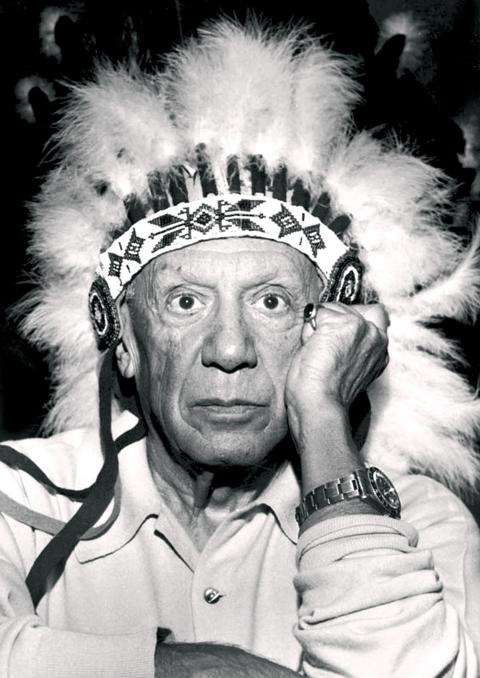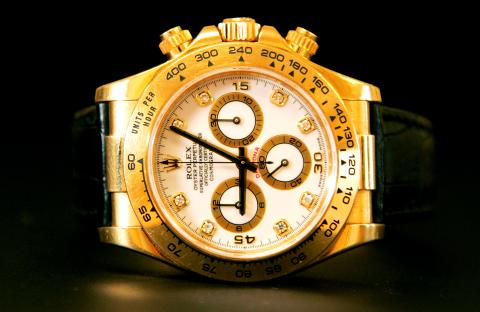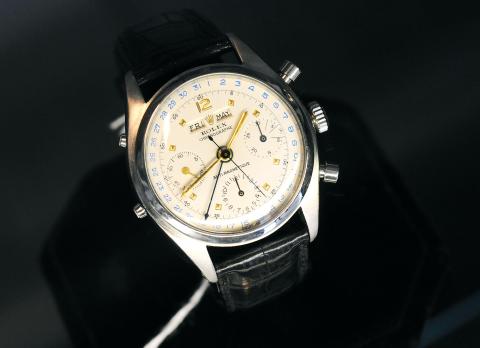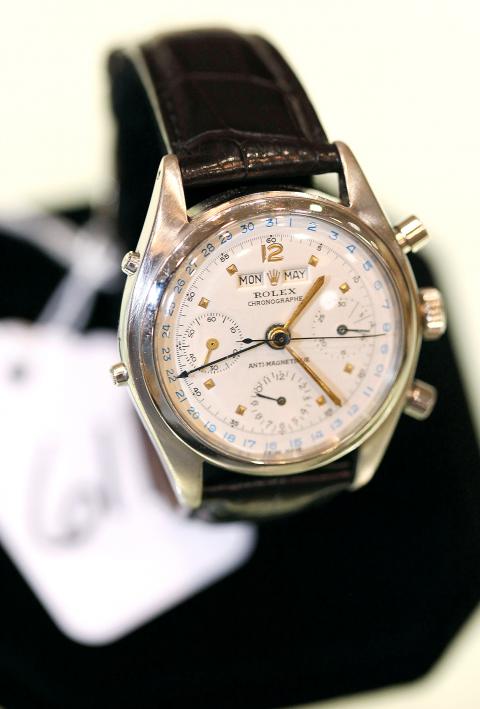Along an Alpine fairway veiled between the private banks of Geneva and the lakefront estates of their jumpy Swiss depositors, Jean-Noel Bioul taps his wrist and offers clients the ultimate in luxury shielding for perilous economic times.
The product costs around US$7,000 and current investors include guitarist Eric Clapton and actor Daniel Craig. It was developed in 1956 with the help of physicists at the nearby European Organization for Nuclear Research, site of CERN’s Hadron Collider. The item weighs 157g and is guaranteed to tell the correct time during thermonuclear incidents that release up to 1,000 Gauss of magnetic field density.
“The Milgauss is the one model that comes with a lightning bolt as the second hand,” says Bioul, the 57-year-old international sponsorship director of the Geneva-based watchmaker Rolex Group. It’s the only maker of timepieces that also can supply an unscripted photograph of Pablo Picasso wearing an American Indian war bonnet on his head and a Rolex Oyster Perpetual Chronometer on his wrist.

Photo: Bloomberg
Luxury watchmakers are specialists at concocting marketing campaigns to explain why their brand can take a licking and keep on ticking. Yet closely held Rolex doesn’t disclose its financial details let alone tell how a GMT-Master — strapped to the wrist of Che Guevara in 1956 — sailed into Cuba with Fidel Castro aboard the yacht Granma and was used to time guerilla activities. Select Rolex owners, though, play a key role in the company’s classy branding strategy.
Swiss bank
“We have the reputation of operating like a Swiss bank,” Bioul chuckles on a patio at the Geneva Golf Club’s Rolex Trophy-Challenge Tour, an annual event since 1991. “That’s changing, slowly.”

Photo: Bloomberg
Rolex annually makes 700,000 watches, Bioul says. Growth markets in China and India helped cushion the company against the Swiss franc’s overvaluation against the euro during this summer’s currency crisis, he says. A Goldman Sachs Group Inc report last month slashed Swiss growth forecasts for next year to 0.6 percent from 2 percent. Last Wednesday, the Swiss National Bank decided to cap the franc’s rate to protect trade.
“We’re still doing well in Europe and North America, even in a global economy that’s difficult,” says Bioul, who joined Rolex in 1993 after helping manage Mark McCormack’s London-based sports marketing company International Management Group. “Rolex has never been pressured by time, but we pride ourselves on being able to change with the times to ensure growth in a dignified manner.”
Scraps of paper

Photo: Bloomberg
Central to that philosophy, set down by Rolex co-founder Hans Wilsdorf, are some 102 years of Rolex chronicles kept in the company’s archives. Bioul says these scraps of paper, photographs and statements on the reliability and enduring fashion of a Rolex watch are the institutional backbone of the company’s continuing financial success under chief executive officer Gian Riccardo Marini, who in May succeeded Bruno Meier as head of the biggest luxury-watch brand.
The characters in these stories who capture Rolex’s imagination are singularly called “Testimony,” a grammatically clumsy proper noun that refers to individuals or organizations (such as tennis star Roger Federer, tenor Placido Domingo and the Royal & Ancient Golf Club of St Andrews) tapped to contractually star in ad campaigns.
The first thing Bioul does when he spots someone wearing a Rolex is to ask them to recount the story of the watch.

Photo: Bloomberg
Rolex family
“Every Rolex owner has a personally passionate story to tell about their watch and everyone who wears a Rolex is immediately looked upon as an investor and a member of the Rolex family,” Bioul says. “They’re our representatives and we want to know about them.”
Elevation to Testimony status is rigorous. “Virtually all Testimonies already wear a Rolex,” Bioul says. “We listen and then fact-check the story behind them and their watch. Do the story and individual meet the dignity of the brand? If so, we offer Testimony. It’s not about money. You don’t become rich with a Rolex watch deal.”
Testimonies usually receive a three-year contract valued at around US$40,000 and US$34,000 worth of Rolex watches over the duration of the agreement, according to a former Testimony who asked to remain anonymous because the parties to the negotiation had promised to keep details confidential.
“You’ll never find a baloney story at Rolex,” Bioul says. “A Testimony must already be in love with the watch and its capabilities. If they’re in it for the money, we’re not interested.”
Channel swimmer
Although Rolex’s first official Testimonies were 1960s sports superstars Arnold Palmer, Jackie Stewart and Jean-Claude Killy, Bioul says Wilsdorf started the program in 1927, when he asked Mercedes Gleitze to wear a Rolex during her swim of the English Channel to show a skeptical public that the Oyster case was rugged and waterproof.
“That was the beginning of Testimony,” says Bioul, who today manages a stable of 120 Testimonies in categories that include golf, yachting, tennis, equestrian, exploration, auto racing, the arts and an eight-man, eight-woman scuba team who last year explored life in the frigid waters under the North Pole wearing Sea-Dweller DEEPSEA watches.
“We keep our eyes open, we quietly look for achievements of discovery, human qualities, regardless of how famous or as of yet accomplished the individual,” Bioul says.
Executive’s challenge
Back in the mid-1970s, for instance, Rolex’s then-CEO Patrick Heiniger was at a golf tournament when he spotted a despondent young man who failed to make the cut. “Heiniger took him aside and said, ‘Let’s go out and play the back nine. If you can beat me, I want you to represent Rolex,’” Bioul says.
The kid whipped Heiniger and became a Testimony. His name was Seve Ballesteros.
In the often balmy world of product placement, Barry Hyde, 45, is an authority on the etiquette of pitching pricey aspirational goods. He’s chief marketing officer for the United States Golf Association in Far Hills, New Jersey. His job is to ensure professional golf doesn’t become entangled with underwriters who might tarnish the association’s reputation.
“Golf, tennis, even the arts have a culture ripe to be exploited by sponsors,” is Hyde’s verdict. “This happens all the time but never with Rolex. I might not know much about the fine arts, but if I see a Rolex ad about an artist I’m going to read it because I know the person will be compelling.”
Racing daytona
Tom Kristensen is Testimony even though he didn’t wear his Rolex Daytona race watch during the eight first-place finishes at the wheel of an Audi in the 24 Hours of Le Mans.
“The Daytona does nothing in the cockpit of a modern race car,” Kristensen, 44, says. “All the analog information the watch supplies is digitally transmitted to the car by computer. Yet the Daytona is useful when I drive AC Cobras and other classic racers at competitive events like Goodwood.”
Kristensen says Rolex values the protocols of his risky culture. “Traditional sponsors are not like that,” says the Testimony Rolex describes as “the man who can’t slow down.”
“There’s no obligation for me to attend any Rolex event,” Kristensen says after sinking a birdie putt. “But I do because Rolex family members and Testimonies are fascinating people to meet.”
Over at the clubhouse, Bioul remains on the prowl. He spots a writer wearing a vintage 1975 GMT-Master. There’s another story to tell back at the office.
On the Net: www.rolex.com

When Taiwan was battered by storms this summer, the only crumb of comfort I could take was knowing that some advice I’d drafted several weeks earlier had been correct. Regarding the Southern Cross-Island Highway (南橫公路), a spectacular high-elevation route connecting Taiwan’s southwest with the country’s southeast, I’d written: “The precarious existence of this road cannot be overstated; those hoping to drive or ride all the way across should have a backup plan.” As this article was going to press, the middle section of the highway, between Meishankou (梅山口) in Kaohsiung and Siangyang (向陽) in Taitung County, was still closed to outsiders

US President Donald Trump may have hoped for an impromptu talk with his old friend Kim Jong-un during a recent trip to Asia, but analysts say the increasingly emboldened North Korean despot had few good reasons to join the photo-op. Trump sent repeated overtures to Kim during his barnstorming tour of Asia, saying he was “100 percent” open to a meeting and even bucking decades of US policy by conceding that North Korea was “sort of a nuclear power.” But Pyongyang kept mum on the invitation, instead firing off missiles and sending its foreign minister to Russia and Belarus, with whom it

President William Lai (賴清德) has championed Taiwan as an “AI Island” — an artificial intelligence (AI) hub powering the global tech economy. But without major shifts in talent, funding and strategic direction, this vision risks becoming a static fortress: indispensable, yet immobile and vulnerable. It’s time to reframe Taiwan’s ambition. Time to move from a resource-rich AI island to an AI Armada. Why change metaphors? Because choosing the right metaphor shapes both understanding and strategy. The “AI Island” frames our national ambition as a static fortress that, while valuable, is still vulnerable and reactive. Shifting our metaphor to an “AI Armada”

The Chinese Communist Party (CCP) has a dystopian, radical and dangerous conception of itself. Few are aware of this very fundamental difference between how they view power and how the rest of the world does. Even those of us who have lived in China sometimes fall back into the trap of viewing it through the lens of the power relationships common throughout the rest of the world, instead of understanding the CCP as it conceives of itself. Broadly speaking, the concepts of the people, race, culture, civilization, nation, government and religion are separate, though often overlapping and intertwined. A government